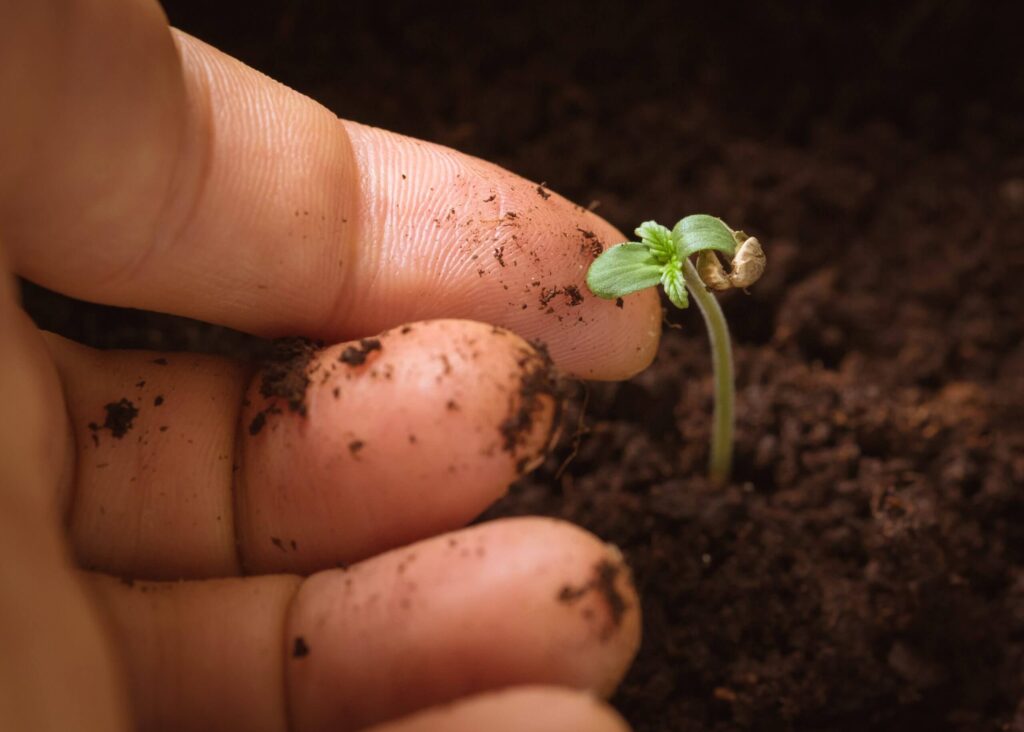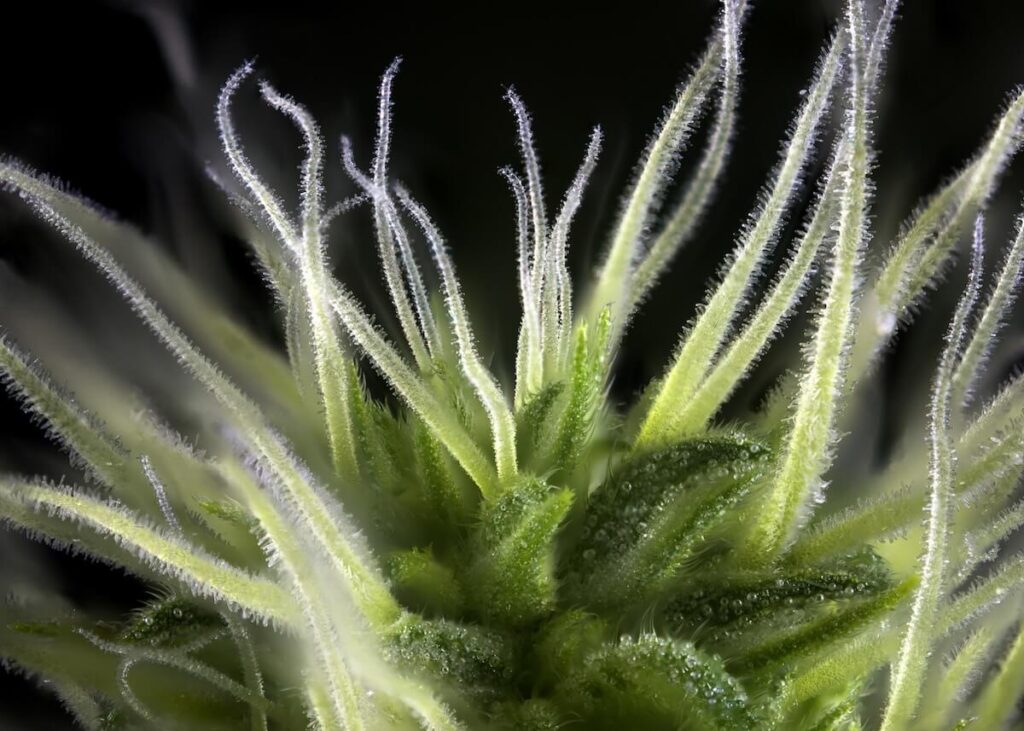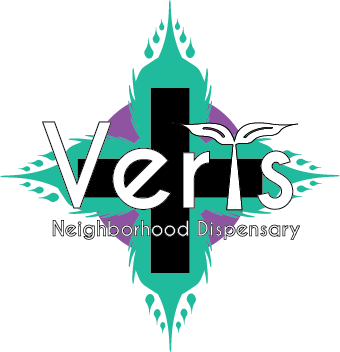What is genotype vs phenotype?
This will all sound a little confusing at first, but don’t worry. We’ll break it down, and by the end of the article you’ll be an expert in cannabis genetics.
A genotype is the unique combo of “alleles” in any given gene. A phenotype is the actual physical result of the genotype. After all, physical characteristics are the result of genetics!
So the genotype is what’s going on in the genes themselves, and then the phenotype is what the genes result in.
To be more specific, let’s talk about a strain of cannabis that has purple tips. The genotype is all the stuff going on within the gene responsible for the purple tips. And then the purple tips themselves are the phenotype.
Genotypes and phenotypes are incredibly relevant to cannabis because they are the foundations of plant breeding…but more on that in the next section!
Besides for some OG heirloom strains that have stood the test of time, the majority of cannabis strains we see on the market today have been slowly bred to perfection by dedicated growers.
Relentlessly sifting through the results of thousands upon thousands of cross-pollination experiments over many decades has gifted us with some pretty epic strains. But these never would have been possible without cultivators who understand how genetics works.
Cannabis genetics control every single aspect of a cannabis plant including (but not limited to):
- Size
- Color
- Health
- Yield
- Smell
- Taste
- Pest resistance
- Mold resistance
- Soil pH requirement
- Terpene content
- Cannabinoid content
- Literally everything about the plant!
And as more and more people turn to cultivation both as careers and hobbies, the strains keep coming and coming!
Of course, we always keep the best of the best in stock- check us out for your favorite classics and the most up-and-coming strains out there!
Beyond getting a variety of new strains, the manipulation of cannabis genetics in cultivation has resulted in different cannabinoid contents seemingly tailored to any need you may have.
We have you covered no matter what you’re searching for!
What is the difference between genotype and phenotype in plants?
As discussed before, genotypes and phenotypes are some of the building blocks of genetics. To truly understand the difference between genotype and phenotype, we’ll have to dive into some new vocabulary and learn a bit about genetics!
Alleles are the contents of a gene. The specific combination of alleles within the gene is known as a genotype. The resulting characteristic is known as the phenotype of the gene.
Plants tend to carry both dominant and recessive alleles for genes. These plants are known as “carriers” since the recessive gene is present in the genotype but doesn’t show itself in the phenotype.
As an example:
Let’s say that purple leaf tips is a recessive allele, and green leaf tips is a dominant allele. If a plant has both alleles, the leaf tips will be green because the dominant allele trumps the recessive allele.
But fret not! This is where breeders get smart. The recessive allele that causes purple leaf tips is still there. So even though those tips weren’t purple, a breeder can still breed a purple-tipped plant by crossing the carrier plant with another plant.
The purple tips and the green tips are both phenotypes- physical results of the genotypes. Simply put, genotype vs phenotype is a matter of cause and effect!

What is a genotype?
According to Nature:
“The term ‘genotype’ refers to the genetic makeup of an organism; in other words, it describes an organism’s complete set of genes.”
More specifically, genotype refers to the exact makeup of the genes of the organism (in our case, a cannabis plant). The genes are made up of alleles in different combinations and groupings.
Alleles are important because some traits are dominant and others are recessive. Depending on the combination of alleles, different traits may pop up that you weren’t expecting- such as a color you didn’t think would arise when you cross pollinated two plants.
This goes back to what we were saying about dominant and recessive alleles before. While they can be manipulated purposefully, they can also lead to some very wonderful surprises- especially at the start of a new hybrid experimentation!
START SHOPPING NOW
Genotype example
There’s a textbook genotype example that is so commonly used to teach the topic that you may even recognize it from high school!
Let’s dive deep into the world of sweet pea flowers.
Sweet pea flower color is determined by two alleles. One allele encourages purple flowers, and we use a capital F to reference it. The other allele, the lowercase f, encourages white flowers.
Therefore, the genotype of sweet pea flowers can be any one of the three following combinations:
- FF
- Ff
- ff
Don’t forget these three combos! We’ll return to them in a second.
What is a phenotype?
A phenotype is the actual expression of the cellular genotype. Here are some phenotype examples in cannabis:
- Large leaves
- Round buds
- Red tips
- A high yield
- Citrus taste
- Musky smell
By knowing about the genotypes that lead to a specific phenotype, breeders can target certain traits in their cultivation.

Phenotype example
Time to check back in on our peas.
Purple flowers- F- is the dominant allele. That means that if an F allele is in the genotype, the flower will be purple. It’s called dominant for a reason!
Meanwhile, white flowers- f- is the recessive allele. That means it will only show itself in the phenotype if both alleles are recessive.
Let’s put this into action!
|
Genotype |
Phenotype |
|
FF |
Purple flower |
|
Ff |
Purple flower |
|
ff |
White flower |
Now that we’ve successfully re-traumatized you with highschool biology, you can take it a step further and think about phenotype cannabis and cannabis genetics.
Consider the phenotypes that you run into often and the phenotypes that are more special. Pink tips? Super rare and cool! It’s probably a recessive trait that’s hard to cultivate. A musky smell, on the other hand? Definitely a dominant trait that breeders try hard to beat.
Why is phenotype used to describe cannabis strains?
The word phenotype is used to describe cannabis strains because the key differences between strains are their phenotypes!
Let’s think about OG Kush. Musky, skunky, and round, dark green nugs.
Blue Dream on the other hand? Sweet, and nugs that can only be described as cute!
So when strains are being described, all the traits listed are inherently phenotypes. That’s just what phenotypes are. But don’t forget that behind every amazing phenotype is an equally amazing genotype!
Why is phenotype used to describe cannabis strains?
The word phenotype is used to describe cannabis strains because the key differences between strains are their phenotypes!
Let’s think about OG Kush. Musky, skunky, heavy-hitting, and round, dark green nugs.
Blue Dream on the other hand? Sweet, floaty, and nugs that can only be described as cute!
So, when strains are being described, all the traits listed are inherently phenotypes. That’s just what phenotypes are. But don’t forget that behind every amazing phenotype is an equally amazing genotype!
What is pheno hunting?
Pheno hunting is short for phenotype hunting- which is exactly what it sounds like!
Breeders hunt for traits during the cultivation process. It can take years on ends to produce the exact trait that a breeder may be hunting.
Once the perfect phenotype cannabis is created, the plant is cloned for mass production.
How to pheno hunt
Let’s give a quick overview on how to pheno hunt.
- Separate out the males. This avoids pollination between the male and female weed plants.
- Pay close attention to each young plant. It’s important to search for plants that grow with vigor!
- See how hardy the plants are. The goal here is to narrow down your options and only consider plants that will grow really well when mass produced. No matter how special, an unhardy plant isn’t fit for scale!
- Count the buds. Counting the buds gives you an idea of how large each harvest may be.
Choose the plant(s)! Based on all the information you’ve gathered, choose the plant(s) you want to keep and clone.
Company
Shopping
Verts Neighborhood Dispensary 2024 | All Rights Reserved
